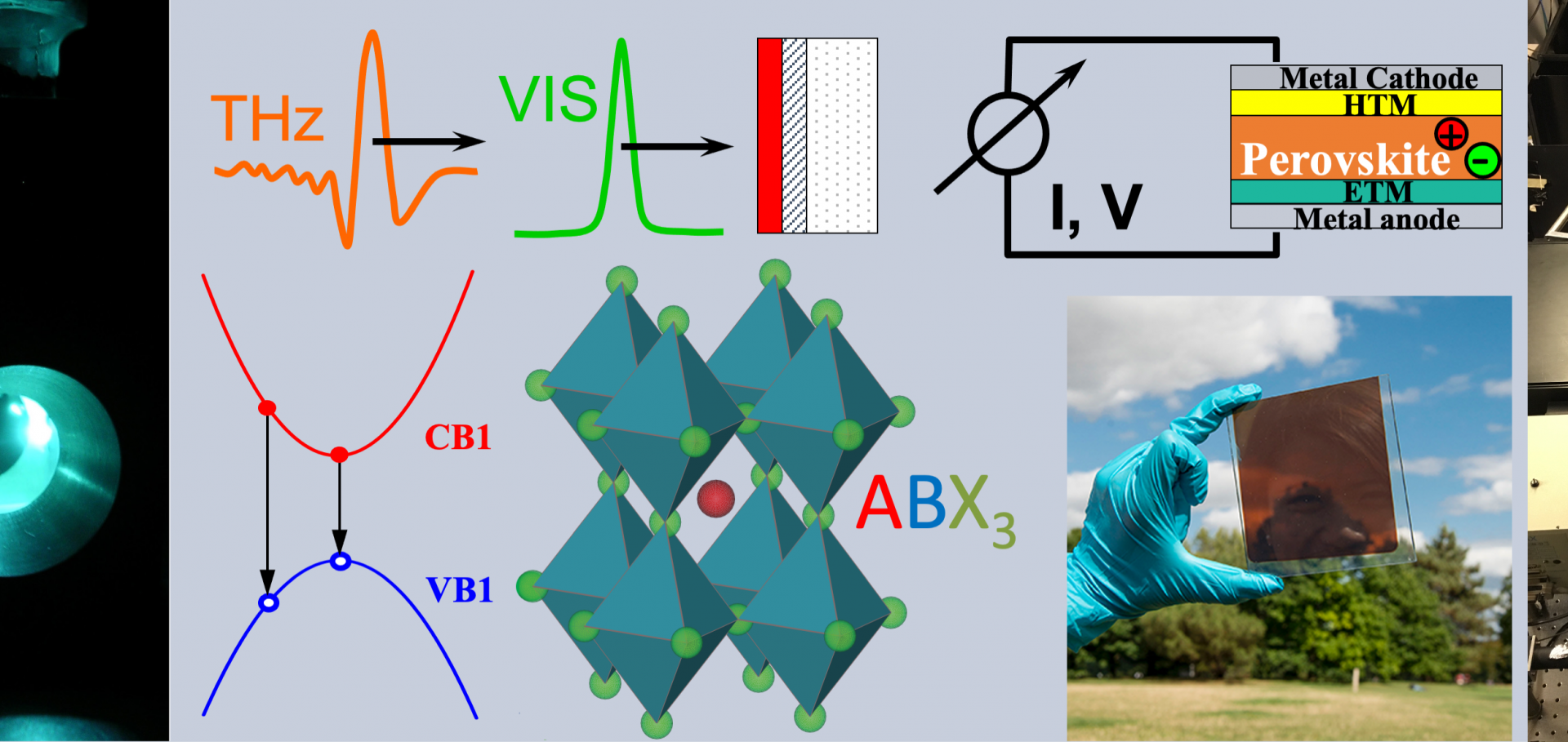Conductivity of nanoporous InP membranes investigated using terahertz spectroscopy.
Nanotechnology 19:39 (2008) 395704
Abstract:
We have investigated the terahertz conductivity of extrinsic and photoexcited electrons in nanoporous indium phosphide (InP) at different pore densities and orientations. The form of electronic transport in the film was found to differ significantly from that for bulk InP. While photo-generated electrons showed Drude-like transport, the behaviour for extrinsic electrons deviated significantly from the Drude model. Time-resolved photoconductivity measurements found that carrier recombination was slow, with lifetimes exceeding 1 ns for all porosities and orientations. When considered together, these findings suggest that the surfaces created by the nanopores strongly alter the dynamics of both extrinsic and photoexcited electrons.Efficient generation of charges via below-gap photoexcitation of polymer-fullerene blend films investigated by terahertz spectroscopy
Physical Review B - Condensed Matter and Materials Physics 78:11 (2008)
Abstract:
Using optical-pump terahertz-probe spectroscopy, we have investigated the time-resolved conductivity dynamics of photoexcited polymer-fullerene bulk heterojunction blends for two model polymers: poly[3-hexylthiophene] (P3HT) and poly[2-methoxy-5- (3,7 -dimethyloctyloxy)-1,4-phenylenevinylene] (MDMO-PPV) blended with [6,6]-phenyl-C61 butyric acid methyl ester (PCBM). The observed terahertz-frequency conductivity is characteristic of dispersive charge transport for photoexcitation both at the π-π* absorption peak (560 nm for P3HT) and significantly below it (800 nm). The photoconductivity at 800 nm is unexpectedly high, which we attribute to the presence of a charge-transfer complex. We report the excitation-fluence dependence of the photoconductivity over more than four orders of magnitude, obtained by utilizing a terahertz spectrometer based upon on either a laser oscillator or an amplifier source. The time-averaged photoconductivity of the P3HT:PCBM blend is over 20 times larger than that of P3HT, indicating that long-lived hole polarons are responsible for the high photovoltaic efficiency of polymer:fullerene blends. At early times (∼ps) the linear dependence of photoconductivity upon fluence indicates that interfacial charge transfer dominates as an exciton decay pathway, generating charges with mobility of at least ∼0.1 cm2 V-1 s -1. At later times, a sublinear relationship shows that carrier-carrier recombination effects influence the conductivity on a longer time scale (>1 μs) with a bimolecular charge annihilation constant for the blends that is approximately two to three orders of magnitude smaller than that typical for neat polymer films. © 2008 The American Physical Society.Mesoscopic order and the dimensionality of long-range resonance energy transfer in supramolecular semiconductors.
J Chem Phys 129:10 (2008) 104701
Abstract:
We present time-resolved photoluminescence measurements on two series of oligo-p-phenylenevinylene materials that self-assemble into supramolecular nanostructures with thermotropic reversibility in dodecane. One set of derivatives form chiral helical stacks, while the second set form less organized "frustrated" stacks. Here we study the effects of supramolecular organization on the resonance energy transfer rates. We measure these rates in nanoassemblies formed with mixed blends of oligomers and compare them with the rates predicted by Forster theory. Our results and analysis show that control of supramolecular order in the nanometer length scale has a dominant effect on the efficiency and dimensionality of resonance energy transfer.Dynamics of excited-state conformational relaxation and electronic delocalization in conjugated porphyrin oligomers.
J Am Chem Soc 130:31 (2008) 10171-10178
Abstract:
We have investigated the influence of nuclear geometric relaxation on the extent of the excited-state electronic delocalization in conjugated zinc porphyrin oligomers using ultrafast transient photoluminescence spectroscopy. By use of metal-coordinating templates that force the oligomers into specific geometries in solution we are able to distinguish clearly between relaxation effects arising from the two vibrational modes that preferentially couple to the electronic transitions in such materials, i.e., carbon-carbon bond stretches and inter-ring torsions. We find that light absorption generates an excited state that is initially strongly delocalized along the oligomer but contracts rapidly following vibrational relaxation of the nuclei along C-C stretch coordinates on the subpicosecond time scale. We are able to monitor such excitonic self-trapping effects by observing the extent to which the concomitant ultrafast rotation of the transition dipole moment is found to correlate with the degree of bending induced in the molecular backbone. We further demonstrate that interporphyrin torsional relaxation leads to a subsequent increase in the excited-state electronic delocalization on a longer time scale (approximately 100 ps). Such dynamic planarization of the molecular backbone is evident from the time-dependent increase in the overall emission intensity and red-shift in the peak emission energy that can be observed for wormlike flexible porphyrin octamers but not for torsionally rigidified cyclic or double-strand octamer complexes. These results therefore indicate that, following excitation, the initially highly delocalized excited-state wave function first contracts and then expands again along the conjugated backbone in accordance with the time periods for the vibrational modes coupled to the electronic transition.Enhanced π Conjugation around a Porphyrin[6] Nanoring
Angewandte Chemie Wiley 120:27 (2008) 5071-5074


